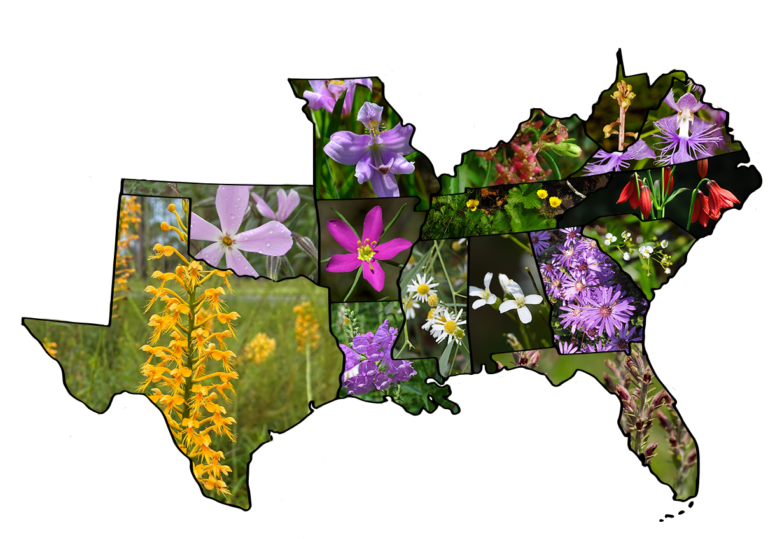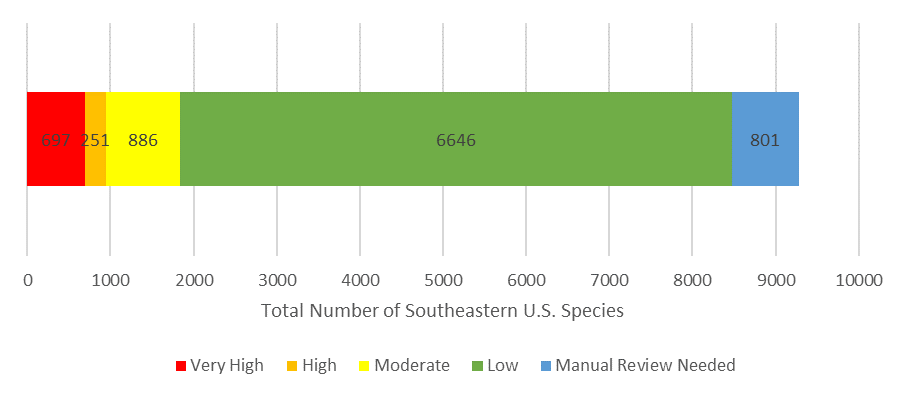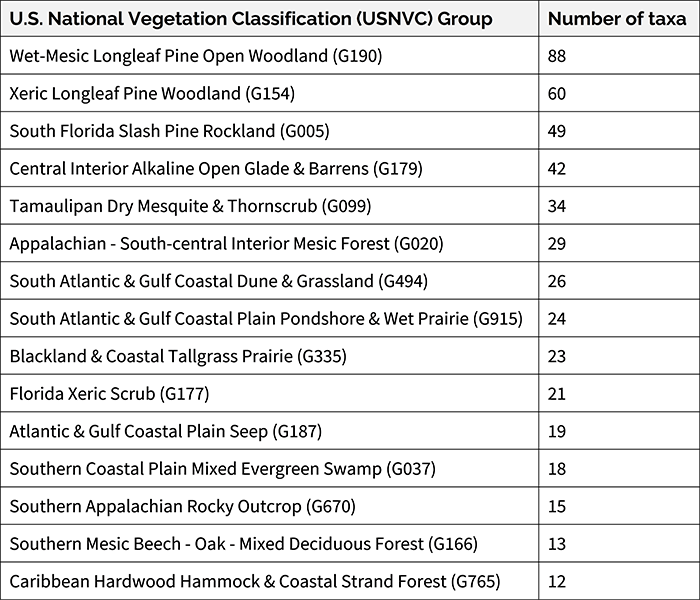The nation’s first Regional Species of Greatest Conservation Need list for plants

Background
Working with a coalition of partners, the Southeast Plant Conservation Alliance has created the nation’s first Regional Species of Greatest Conservation Need (RSGCN) list for plants! Collaborators included the Atlanta Botanical Garden, NatureServe, and Terwilliger Consulting, with funding from the U.S. Fish and Wildlife Service. This list narrows down the vast number of plants native to the Southeast to 1,824 species that are a regional conservation priority based on criteria such as rarity, threats, and needed conservation actions. The plant RSGCN list complements the Southeastern animals RSGCN list developed in 2019 to create a more complete picture of our region’s exceptional biodiversity.
The Southeast is home to more than 11,000 native plant species, 30% of which are endemic (i.e., found only in the Southeast). Nationally, 34% of plants and 40% of animals are at risk of extinction, and 41% of ecosystems are at risk of range-wide collapse. The Southeastern plant RSGCN project will help combat these trends by supporting long-term conservation goals for imperiled Southeastern plant species, enhancing data, consistency, capacity, and awareness for plant conservation regionwide.
To learn more about this project, tune in to our upcoming Third Thurday Web Forum on January 18th @ 10 am ET. You can register via Zoom.
Identifying Regional Species of Greatest Conservation Need
To develop a pool of potential species to draw from, NatureServe compiled a list of more than 10,000 vascular plants native to any of the SEAFWA states (Alabama, Arkansas, Florida, Georgia, Kentucky, Louisiana, Mississippi, Missouri, North Carolina, Oklahoma, South Carolina, Tennessee, Texas, Virginia, West Virginia), considering each species’ G-Rank (global rarity), S-Rank (state rarity) and endemism. Unfortunately, due to data limitations, plants native to Puerto Rico and the U.S. Virgin Islands could not be included.
The full list received extensive review from botany experts, a technical team composed of representatives from each state, and NatureServe. Based on partner feedback, the technical team assigned each species a Level of Conservation Concern rating ranging from low to very high or “manual review needed”. Any plant scoring moderate or above was ultimately considered an RSGCN. After cleaning the data to remove redundancies, the complete Southeastern plant list evaluated 9,271 species and prioritized 1,824 as RSGCN. 72% of the plant RSGCN are endemic to the Southeast.

To supplement the overall Level of Conservation Concern, we gathered feedback on the primary threats facing each RSGCN and their most critical conservation needs. The top threats encompassed a range of human modifications to natural ecosystems, invasive species and diseases, and climate change. The top conservation actions included land protection, restoration, monitoring, reintroduction, and prescribed fire.
RSGCN Habitat Linkages
To better understand shared plant needs and threats at the ecosystem level, we crosswalked each RSGCN to its primary habitats using U.S. National Vegetation Classification (USNVC) “Groups”. The USNVC provides a standardized system of classifying vegetation types and habitats has been widely used by organizations like the National Park Service and mapping efforts like LANDFIRE. The distribution of RSGCN across ecosystems demonstrates their diversity and broad geographic extent. A total of 31 USNVC Groups contained at least 10 RSGCN, indicating that many of the region’s ecosystems support species of conservation need. As many of these same habitats tend to provide crucial habitat for animal RSGCN as well, conserving these ecosystems will safeguard regional biodiversity more broadly.

Applications and Next Steps
Insights gleaned through the plant RSGCN process are already being applied. An in-person RSGCN ranking workshop in October 2022 updated G-ranks for a subset of species determined to need a global rank review by NatureServe. A second RSGCN ranking workshop is scheduled for February 2024.
As SEAFWA states move to include plants as SGCNs and identify Conservation Opportunity Areas in their State Wildlife Action Plan (SWAP) updates, the RSGCN list will serve as an important resource. Another phase of this project is already underway to summarize available information about climate impacts, vulnerability, and tools. In addition to informing SWAPs, anticipating potential climate impacts to rare plants and their habitats can also aid botanical research and conservation efforts, state-level planning, rare species monitoring, and Species Status Assessments conducted by the U.S. Fish and Wildlife Service for listed and at-risk plants.
We expect to revise the Southeastern plants RSGCN every 5-10 years to incorporate data updates, including State and Tribal SGCNs. Although the current list does not include Puerto Rico or the U.S. Virgin Islands, this project can help lay the groundwork for improving data availability and prioritizing species to inform SGCN updates in those territories. Inclusion of Tribal Nations and historically underprivileged groups will support more cohesive collaboration across the region, especially around culturally significant plants.
Conclusions
Unless we enact change, an estimated 1,000,000 plant and animal species–because of habitat destruction, invasive species, pollinator loss, climate change, and other threats–face extinction. The Southeast can serve as a model of leadership for the nation in our ability to address needs and achieve success. Our shared committment to assess and preserve the biodiversity of plants and ecosystems underlies the sustainable and continued existence of other organisms, including humans. We can achieve this by uniting efforts in the region and beyond, and by demonstrating that plant conservation is a crucial asset in conserving the systems that support all other lifeforms, as well as our own well-being.
Acknowledgements
Collaboration with all parties and organizations involved in the first Southeastern plant RSGCN list illustrated the breadth of potential for this effort. The Southeast Plant Conservation Alliance is a public and private partnership of professionals bridging gaps between local and national plant conservation efforts and collaborating to prevent and restore the loss of plant diversity in the Southeast United States. Thanks to the many partners involved, including NatureServe and the NatureServe Network, Terwilliger Consulting, Inc., Allan Weakley of Flora of the Southeastern United States, Scott Ward at the Southeastern Flora of the United States Project at the North Carolina Botanical Gardens, SEAFWA, the Southeast Climate Adaptation Science Center, and the Oak Ridge Institute for Science and Education, along with the members of the Survey, Technical, and Ranking Teams.